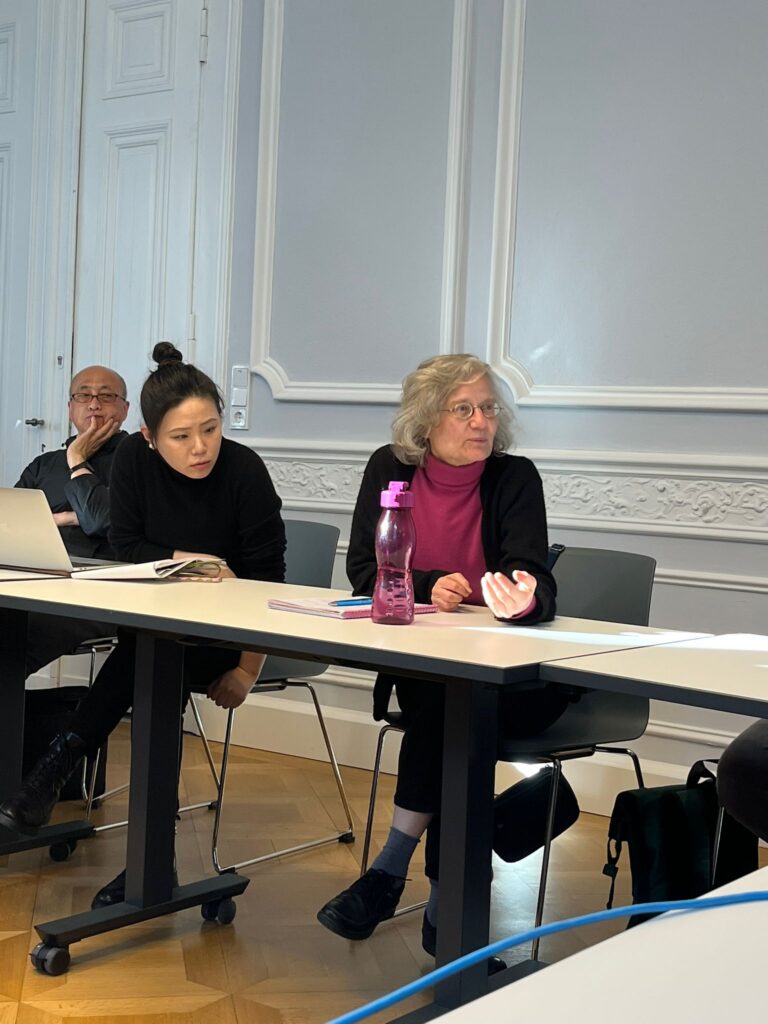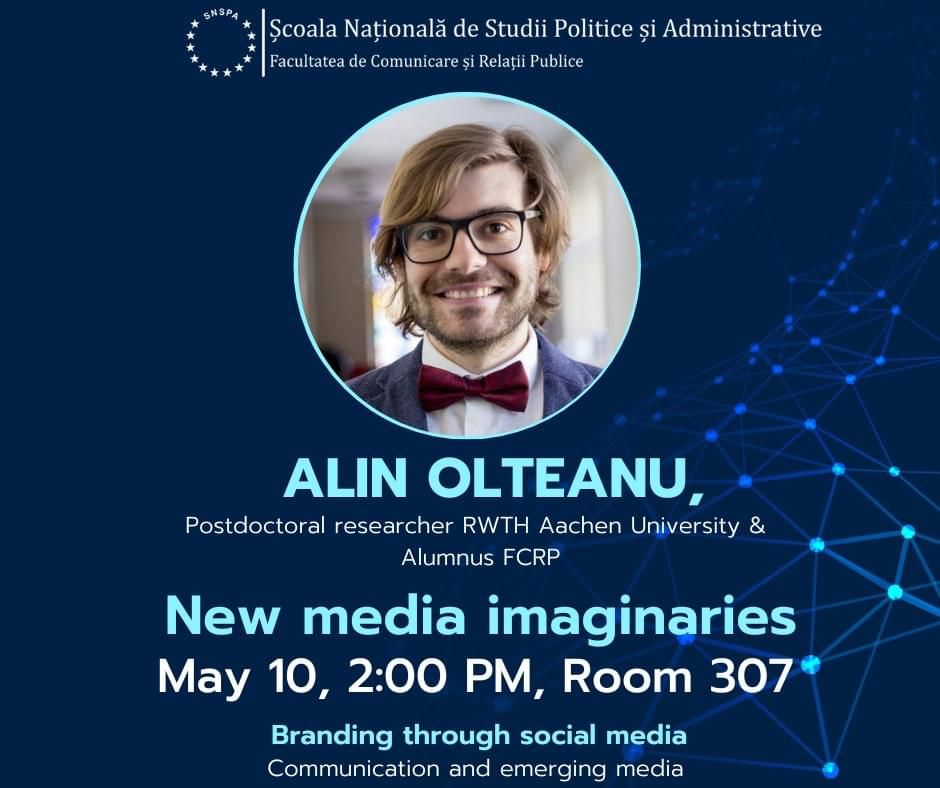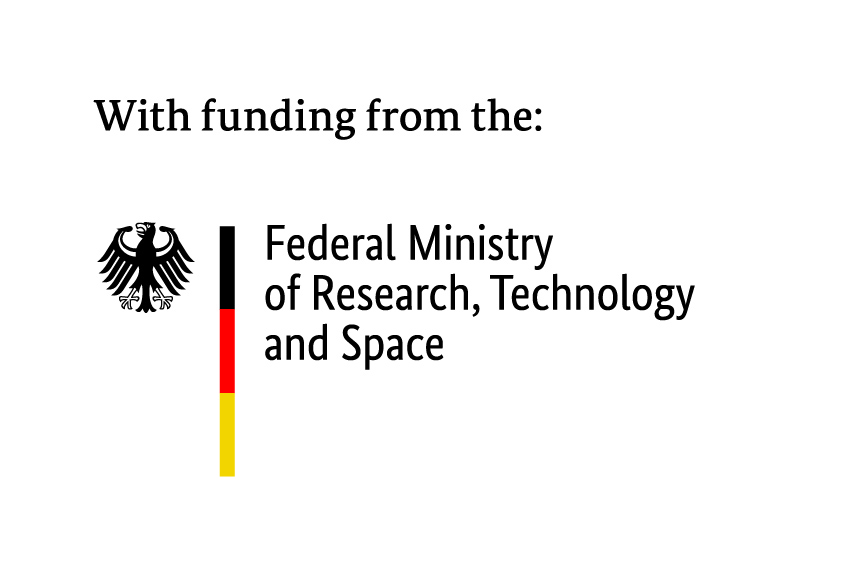EASST Review on STS Hub
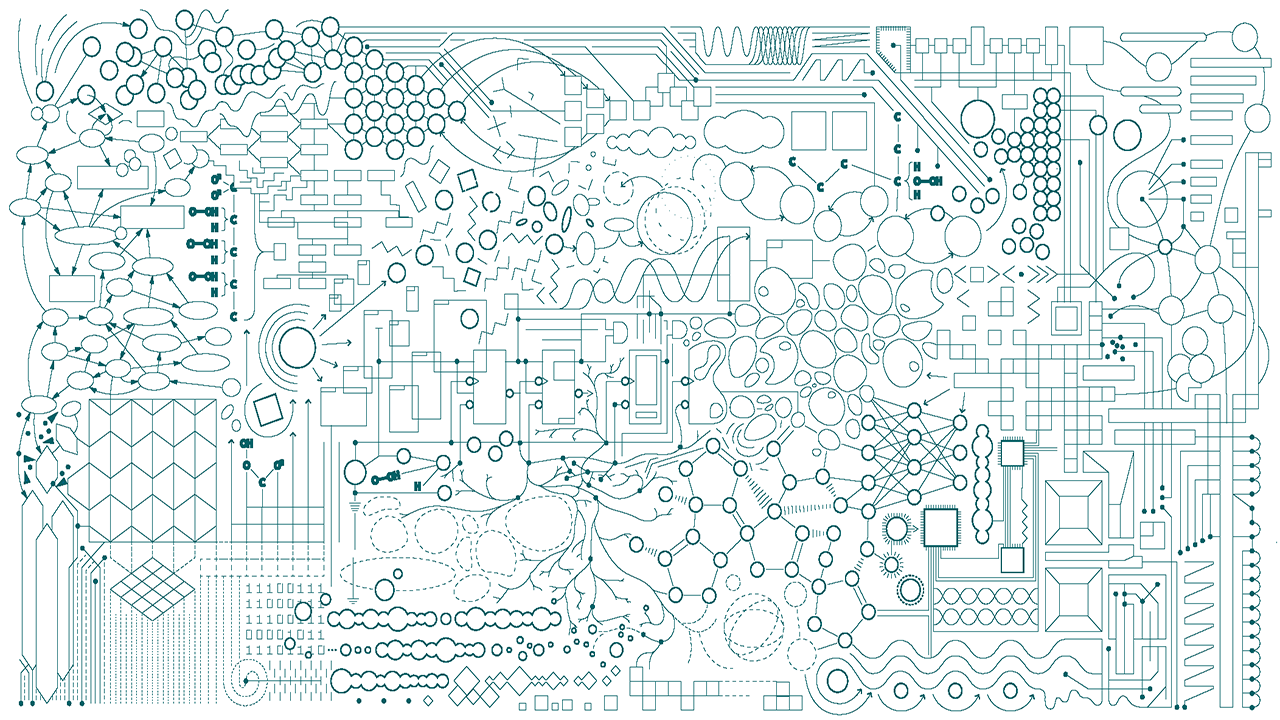
If you are interested in Science and Technology Studies, we recommend the insightful report on the STS Hub 2023 that our colleague Mareike Smolka co-authored in the EASST Review, here. You can also read about this event on the khk blog.
Varieties of Science 2. European traditions of varieties of science: Unexpected varieties
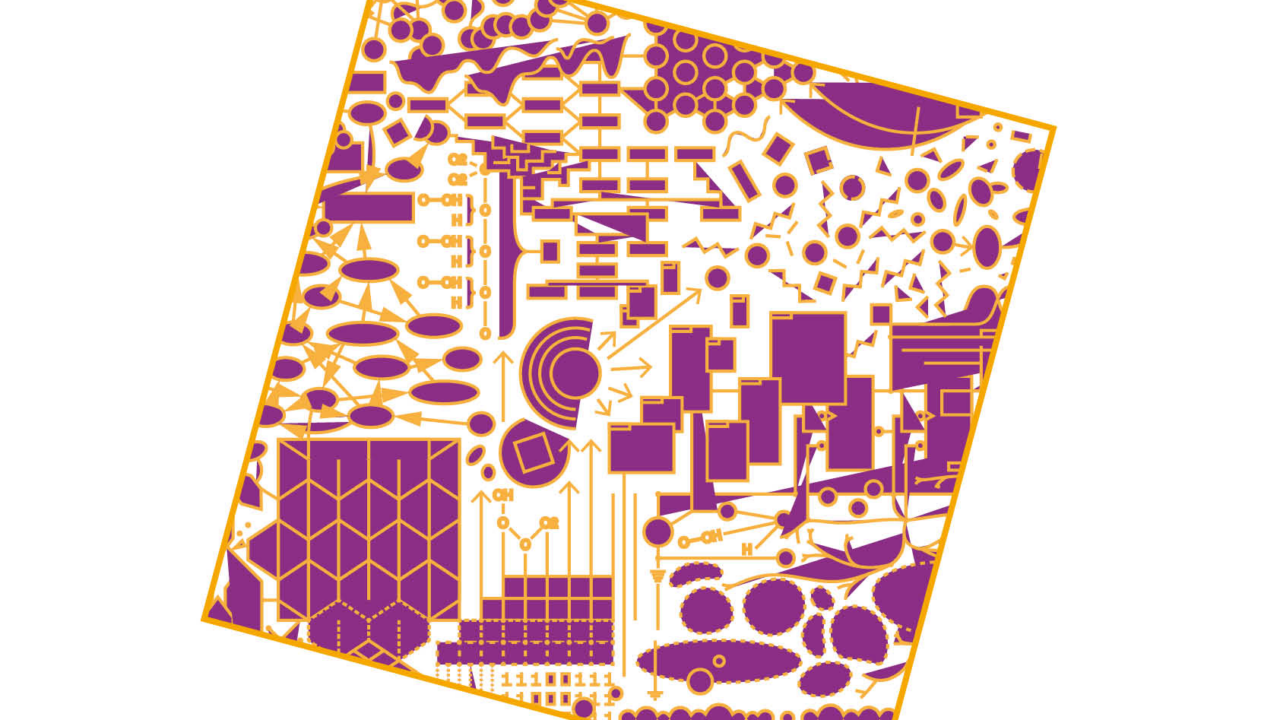
On May 5-6 the second c:o/re workshop Varieties of Science took place. While the first workshop (Patterns of knowledge) of this series was hosted by the National Autonomous University of Mexico and focused on decolonizing STS, this second workshop addressed some Unexpected varieties, namely the diversity within European philosophy and science traditions. The event was hosted by the Faculty of Philosophy of the University of Bucharest.
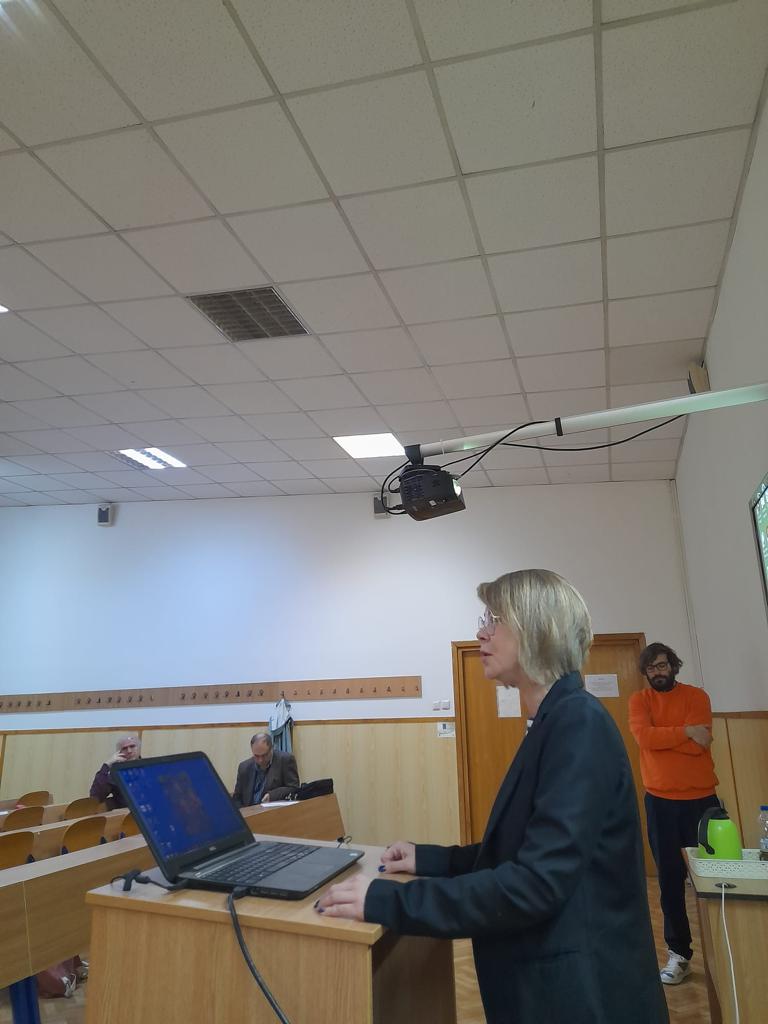
The event took off with Vice-Dean Andrei Marasoiu warmly welcoming the participants to the Faculty of Philosophy and explaining how the rationale of the Varieties of Science workshops is approached at this particular event, in light of the common interests on philosophy of science of c:o/re and the Department of Theoretical Philosophy in Bucharest (see Pârvu, Sandu, Toader 2015).
Before diving into the talks, as a main concern under the Varieties of Science theme, we were happy to listen to Dr. Andreea Popescu‘s announcement that the Association of Women in Philosophy in Romania is about to be established. Information on this Association will be available on the c:o/re website as soon as it is launched.
The common thread throughout talks spanning over two days was the concept of observation.
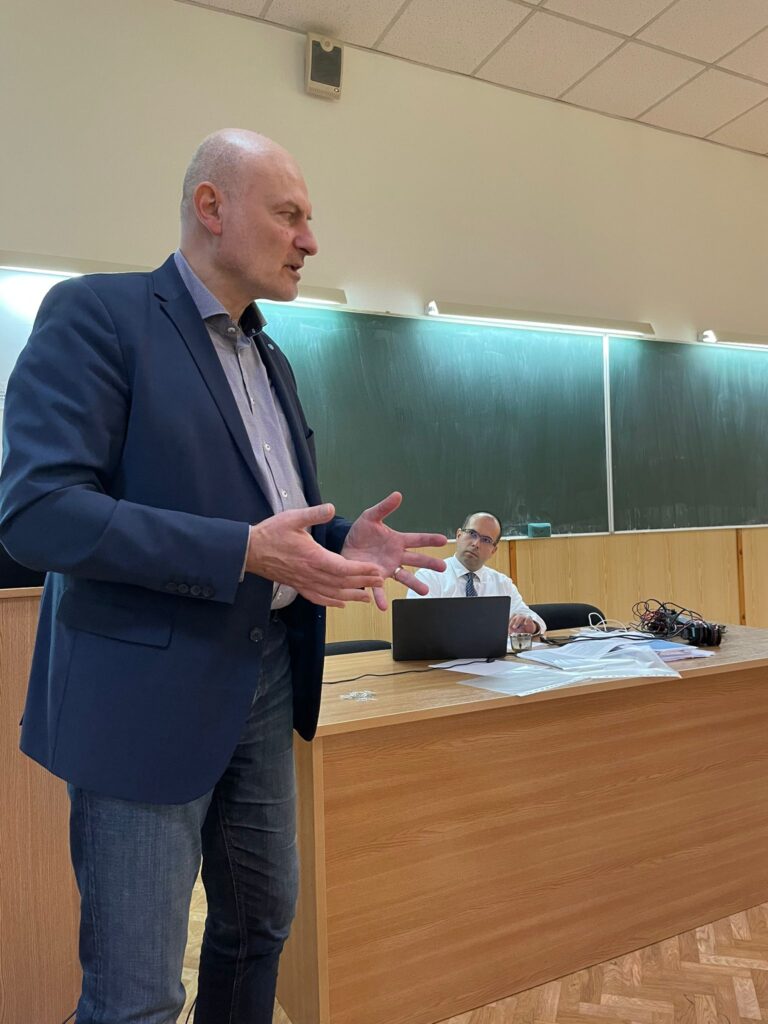
c:o/re director Professor Stefan Böschen delievered the first talk of the workshop, introducing the broad concept of Varieties of Science, in particular consideration of philosophical inquiry, wherein varieties of schools particularly abound. The notion, as propposed by Böschen (see Böschen et al. 2020), relies on Ulrich Beck’s (2006) Varieties of Capitalism, which addresses cosmopolitization in a dialectics of homogenization and heterogenization. Böschen remarked the effects of the “different anchors” for doing philosophy of science in different places. This led to considerations on epistemic truths and epistemic injustice, validity of knowledge, matters of representation and science communication and politics. By asking how can different formations of society be analysed in their peculiarity and relationality within the perspective of cosmopolitisation, Böschen proposes theorising processes of globalisation in awareness of “the other in the midst”. In this talk, he pointed to the importance of making premises visible and critically analysing one’s own presumptions under others’ views.
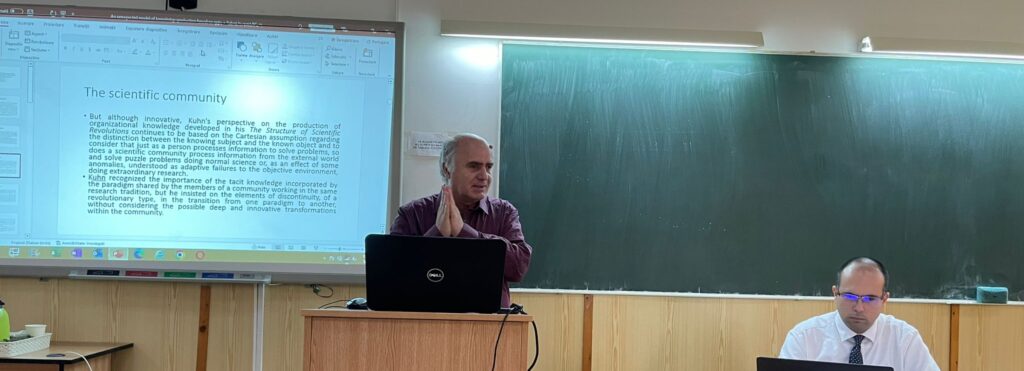
The second talk, delivered by Professor Constantin Stoenescu, addressed the dialogue between a Japanese culturally-based model of knowledge and Western philosophy. The foci fell on knowledge conversion and scientific ethos. Stoenescu presented Nonaka and Takeuchi’s (1995) theory, coming from a post-Kuhnean tradition, on the passage from ‘knowledge‘ to practice based tacit know how. He followed the notion of “paradigm as interdisciplinary metrics” and developed a criticism of the reduction of knowledge to merely semantic information. Following scholarship from a Japanese context (e.g., Nishida 1970; Shimizu 1995, Nonaka, Konno 1998), Stoenescu proposed an approach to epistemic variation through the Japanese concept “Ba“, which, for lack of a better option, can be imprecisely translated to English as “place”. From this vantage point, he explained, knowledge is understood as resource.

c:o/re director Professor Gabriele Gramelsberger offered an encompassing and insightful historical and comparative study of the Berlin Group and the Vienna Circle. She traced and, thus, highlighted the remarkable impact of the the Berlin Group for philosophy of science, which have been all too easily overlooked. She observed the shared views and the differences between these two groups, as illustrated to begin with, by logical positivism in Vienna and the logical empiricism (observatism) in Berlin. Both these groups, Gramelsberger, explained shared the destiny of “emigration, disintegration and new beginnings”, as they had to seek safety in the USA, given the coming to power of social nationalism in Germany in the 1930s. Because of its location, the Berlin group was more fiercely persecuted, which is one possible explanation for the enduring lack of awareness of its importance.
Gramelsberger identified three varieties by looking at these groups, roughly summarized here as:
- The comparative approach of the Berlin group, interested not only in empirical sciences, but also in analyzing theoretical sciences and mathematics;
- A focus on the role of theory of probability and logic;
- The pathway to Wittgenstein’s linguistic turn.
This exploration led Gramelsberger to remarking the linkages between early analytic philosophy and Gestalt theory, with possible connections also to phenomenology. As a conclusion and programmatic future work to be undertaken at c:o/re, Gramelsberger hypothesized on Paul Oppenheim’s Dimension of knowledge (1957) as overlooked by scholarship in this pathway of intellectual history.
The next two talks were delivered by the invited guests, Professor Gabriel Sandu and Professor Alexandru Baltag, who drew the focus of the workshop more closely towards analytical approaches. Main points of departure in their talks were Lewis’ (1973) reduction of causal relationship to counterfactual dependence and and von Wright’s (1976) manipulationist counterfactuals.
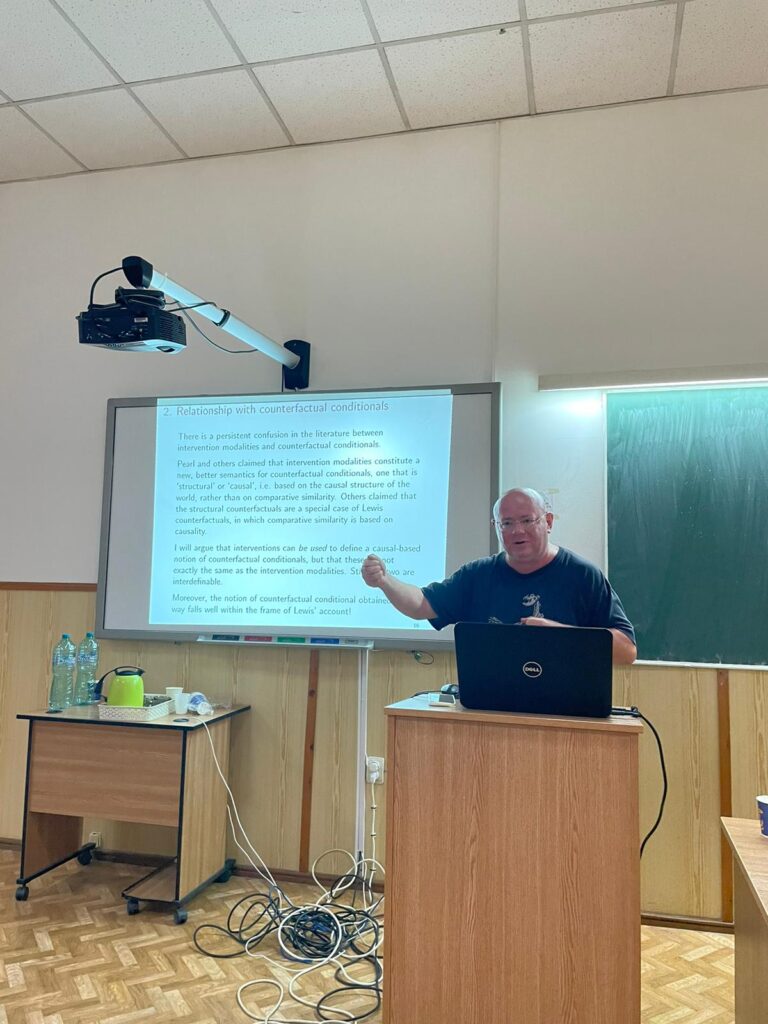
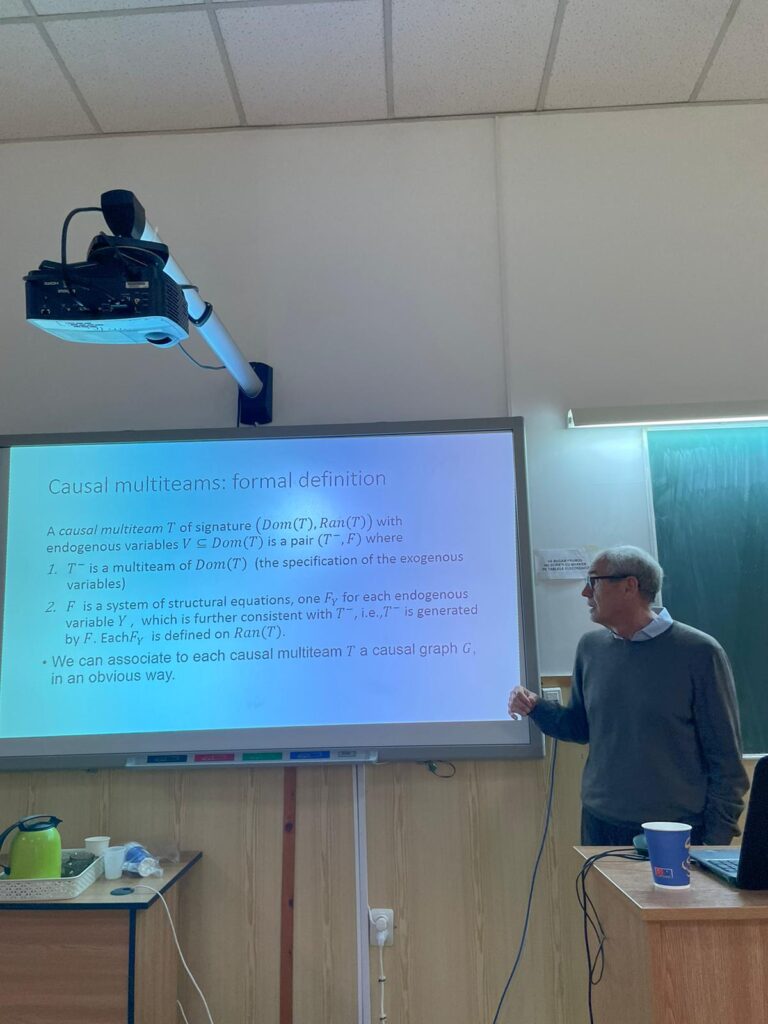
Gabriel Sandu proposed A logical framework for interventionist counterfactuals. Here, a causal relationship is considered to sustain a counterfactual assumption expressed thus: “on occasions where p, in fact, was not the case, q would have accompanied it, had p been the case”. A detailed and highly insightful discussion on possible worlds (Pearl, McKenzie 2018), led Sandu to advocate the notion of multi-teams.
Alexandru Baltag’s talk was titled The dynamic logic of causality: from counterfactual dependence to causal intervention. Starting Pearl’s causal models as the standard/dominant approach to representing and reasoning about causality, Baltag set of to (1) argue that interventions are dynamic modalities, (2) elucidate the relationship between dynamic intervention modalities and counterfactual conditionals and (3) formalize Causal Intervention Calculus. In his view, one should think of interventions, not necessarily as “actual” actions (that may happen in a given world or model), but as counterfactual actions, namely abstract manipulations of the causal structure, that happen to the model (world).
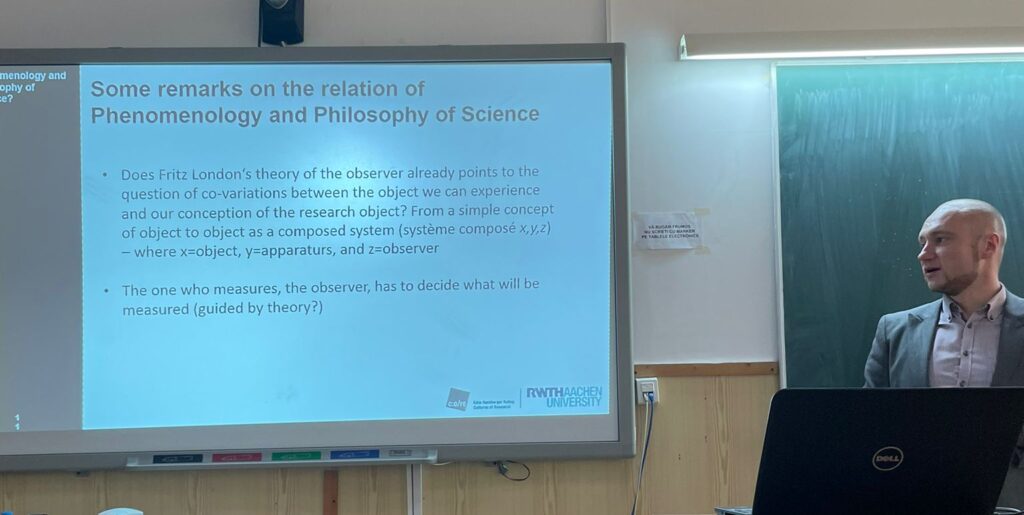
Dr. Markus Pantsar, a c:o/re alumnus fellow and current guest professor at RWTH Aachen, talked on Recognizing artificial mathematical intelligence (see Pantsar 2023). He asked, if AI were developed, how would we be able to recognize it (see Hernández-Orallo 2017)? To answer this question, Pantsar drew on parallels between research in animal intelligence and in aritifical intelligence. These parallels present two types of pitfalls: (1) the false negative that non-human animals have a particular type of intelligence, but we cannot observe them (experimental setting); (2) the false positive of supposing an “accumulator” mechanism instead of arithmetic. From here, Pantsar drew analogies to AI research, making several points, namely that: success in AI does not come down to theorem solving anymore; artificial neural networks are trained with huge amounts of data, and they “learn” statistical connections in the input, given that we have clear criteria for acceptable outputs; mathematics is not a success story of machine learning research, but this might change in the future; the problems of trying to figure out what happens in the hidden layers of the neural network (explainable AI). Pantsar shed light on what these issues have in common by citing the Zulu folk wisdom that “a person becomes a person through other persons”.
The second day of the workshop started with Dr. Dawid Kasprowicz‘ talk, Measurement problems need a consciousness: The case of Fritz London and the relation of Phenomenology to Philosophy of Science. Through a detailed study case on Fritz London (London, Bauer 1939), Kasprowicz tackled the question of how should a deductive theory look like, from a joint phenomenology and philosophy of science perspective (see also Alves 2021)? This opened an in-depth study on observation, the beginning of statistics in physics and the interrogations on observation as intervention that quantum theory produced.
In his talk, A free logic of fictionalism. On failed reference in meaningful discourse, Professor Mircea Dumitru unfurled an insightful criticism of Millianism, the doctrince that in propositions names contribute only to reference. His argumentation points in the direction of Kit Fine’s semantic relationism (see Dumitru 2020). This involved a minute and critical consideration of Sainsbury’s (2005) theory of reference and advocating a historicisation of philosophy of language that suggests the need for an alternative to the mainstream framing of philosophy of language within what is identified as a Fregean-Millian polarisation.
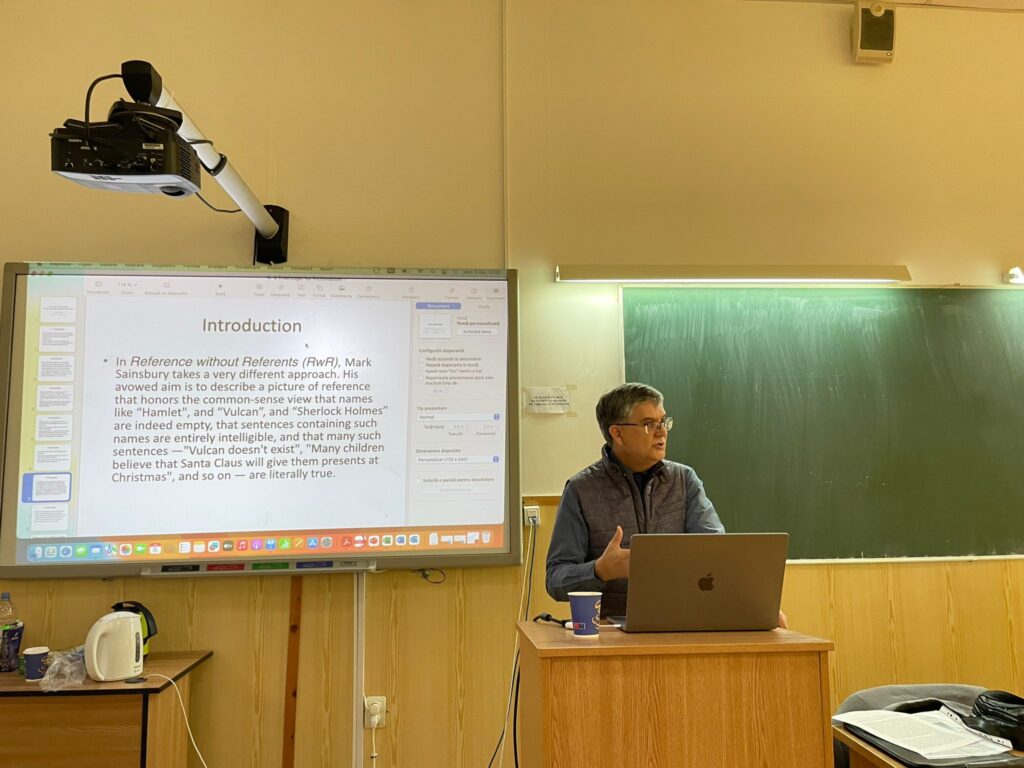
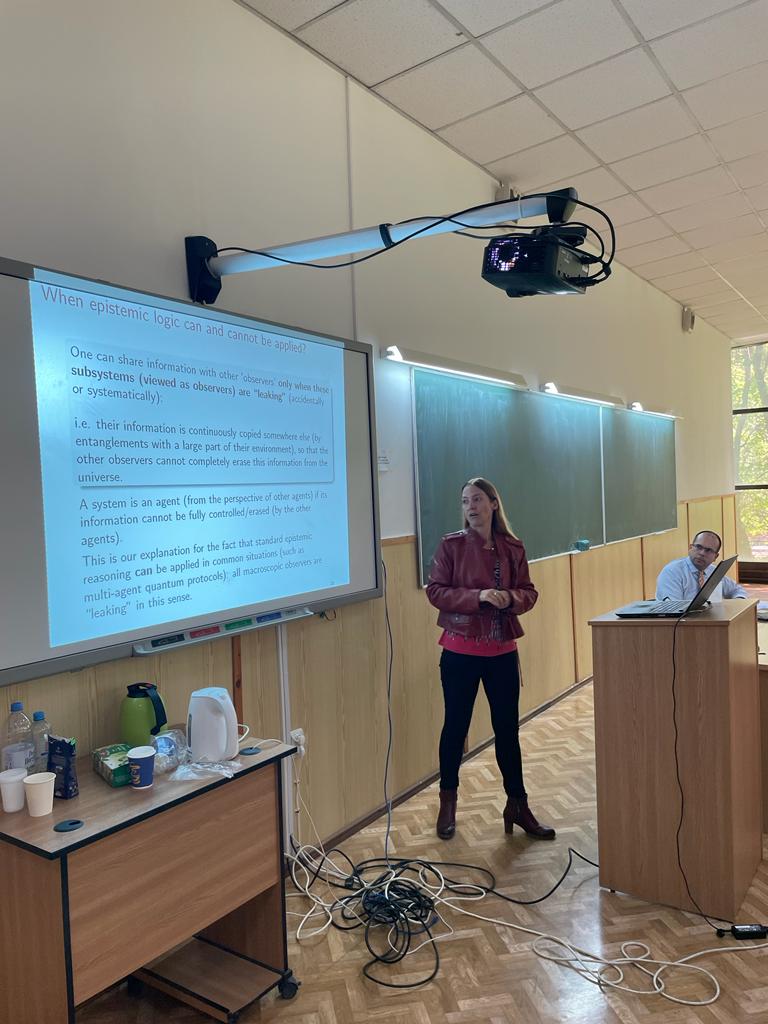
Sonja Smets‘ talk amusingly and wittingly suggested that Logic meets Wigner’s Friend(s): the epistemology of quantum observers. It encompassed an original discussion on the Heisenberg-von Neumann cut, namely the hypothetical interface between quantum events and an observer’s knowledge, in light of the Wigner’s Friend though experiment. In the consideration of observation in experiments, Smets was led to posit a notion of systems as agents and as leaking. She argued that systems can be treated as agents if only if they preserve information.
Professor Dana Jalobeanu proposed a reading of Francis Bacon’s programme for sciences through the heuristics of the fable genre. This reading of Bacon was particularly, but not only, illustrated through reflections on the figure of Salomon’s House in New Atlantis (see Bacon 2000).
Her talk, entitled The fable of science: Francis Bacon’s Solomon’s House and its European reception, shed new light on the history of early modern philosophy, particularly on how (early) modern programmatic narratives of science were rhetorically constructed so to produce the revolution that modernity came to be.
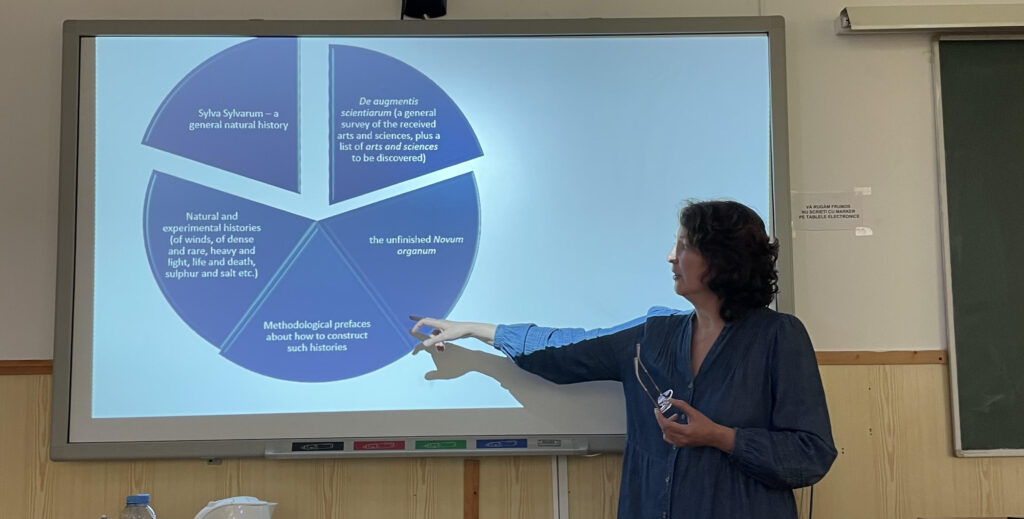
Dr. Arianna Borelli discussed Magic and Machines in the European Renaissance (see Borrelli 2023). She tackled this subject by taking Cornelis Drebbel (1572-1633) as a case study, who built a perpetual movement machine (see Keller 2011). Through this investigation, she problematised the notion of (a modern) “scientific revolution” by revealing the heterogeneity of varieties of science in early modernity. She argued that Drebbel’s perpetuum mobile could have offered a starting point for reflection on science as good as automata or chemical reactions. While it might have led to the emergence of new fields of knowledge, mechanics and chemistry took the main stage of sciencein the 17th and 18th century, which led to the marginalisation in scientific inquiry of the phenomena at the centre of Drebbel’s work.
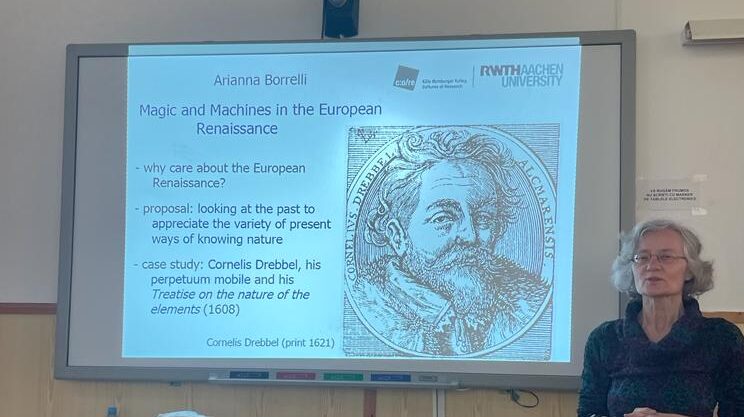
Benjamin Peters examined the material media philosophies of Soviet artificial intelligence research and its precursors, especially the sometimes anthropomorphic, sometimes invisual assumptions at work in the making of smart technologies (further and critically developing scholarship such as Graham 1987, Chun 2021). Through this talk he laid, out in ten clearly defined steps, his c:o/re fellowship project.
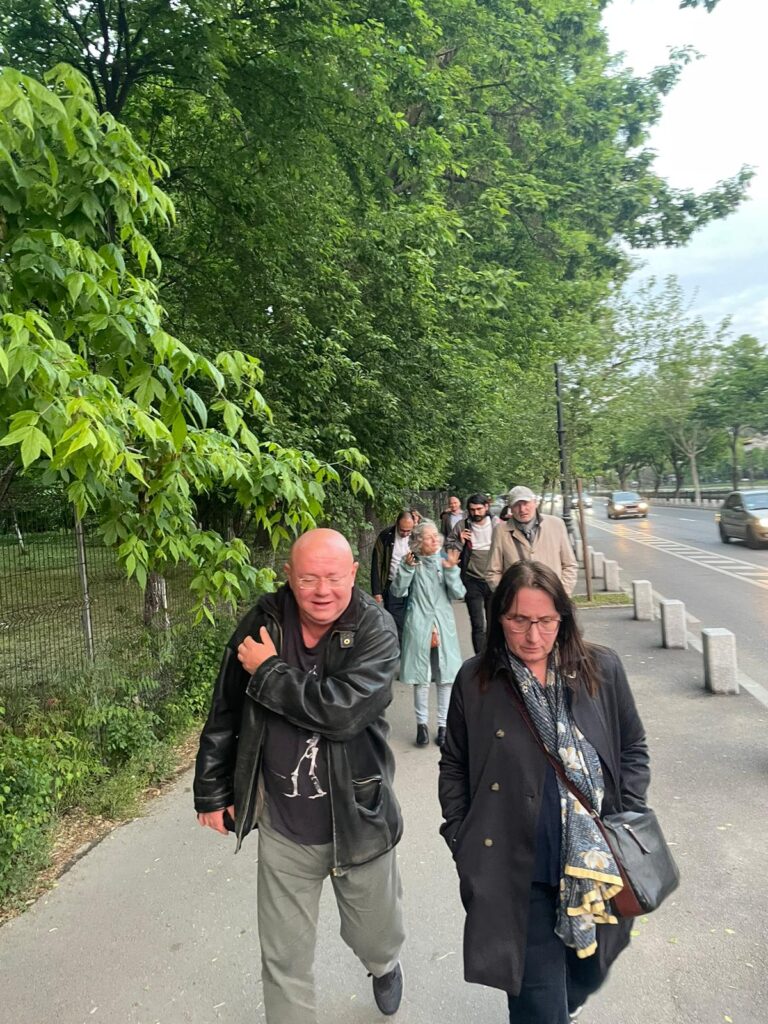
References
Alves, P.M.S. 2021: Fritz London and the measurement problem: a phenomenological approach.Continental Philosophy Review 54: 453-481
Bacon, Francis. 2000. A Critical Edition of the Major Works, edited by Brian Vickers. Oxford: Oxford University Press.
Borrelli, A. 2023. Aristotelianism, chymistry and mechanics in early seventeenth-century Europe. The techno-magical approach. In Verardi, D. Ed. Aristotelianism and Magic in Early Modern Europe: Philosophers, Experimenters and Wonderworkers, pp. 105–44. Bloomsbury Academic.
Beck, U. 2006. Cosmopolitan Vision. Cambridge: Polity Press.
Böschen, S., Hahn, J., Krings, B.-J., Scherz, C., Sumpf, P. 2020. ‘Globale Technikfolgenabschätzung’? Konvergenzen und Divergenzen kosmopolitischer Wissenschaftsdynamiken. In: Soziale Welt, Sonderband 24, p. 332-365.
Chun, W. H. K- 2021. Discriminating data: Correlation, neighborhoods, and the new politics of recognition. Cambridge, MA: MIT Press.
Dumitru, M. (Ed.). 2020. Metaphysics, meaning and modality: Themes from the work of Kit Fine. Oxford: Oxford University Press.
Graham, L. R. 1987. Science, philosophy, and human behaviour in the Soviet Union. New York: Columbia University Press.
Hernández-Orallo, J. 2017. The Measure of All Minds: Evaluating Natural and Artificial Intelligence. Cambridge: Cambridge University Press.
Keller, V. A. 2011. How to Become a Seventeenth-Century Natural Philosopher: The Case of Cornelis Drebbel (1572–1633). In Dupré, S., lüthy, C. Silent Messengers: The Circulation of Material Objects of Knowledge in the Early Modern Low Countries, pp. 125–52. LIT Verlag.
Lewis, D. 1973. Counterfactuals. Oxford: Blackwell.
London, F., Bauer, E. 1939. La théorie de l’observation en méchanique quantique. Hermann Éditeurs.
Nishida, K. 1992 [1970]. An inquiry into the Good. Trans by Abe, M. and Ives, C. New Haven, CT: Yale University Press.
Nishida, K. 1970. Fundamental Problems of Philosophy:The world of Action and the Dialectical World. Tokyo: Sophia University.
Nonaka, I., Konno, N. 1998. The concept of “Ba“: Building a foundation for knowledge creation. California Management Review 40(3): 40- 54
Oppenheim, P. 1957. Dimensions of knowledge. Revue Internationale de Philosophie 40(2): 151-191.
Pantsar, M. 2023. Developing Artificial Human-Like Arithmetical Intelligence (and Why). Minds and Machines. https://doi.org/10.1007/s11023-023-09636-y
Pârvu, I., Sandu, G., Toader, I.D. Eds. 2015. Romanian studies in the philosophy of science. Cham: Springer.
Pearl, J., McKenzie, D. 2018. The book of why. The new science of cause and effect. London: Penguin Books.
Sainsbury, R.M. 2005. Reference without referents. Oxford: Oxford University Press.
Shimizu, H. 1995. Ba-Principle: New Logic for the Real-time Emergence of Information. Holonics, 5(1): 67-69.
Wright, G. H. von. 1976. Causality and determinism. New York: Columbia University Press.
On Aryeh Ludwig Strauss: a German-Hebrew poet from Aachen
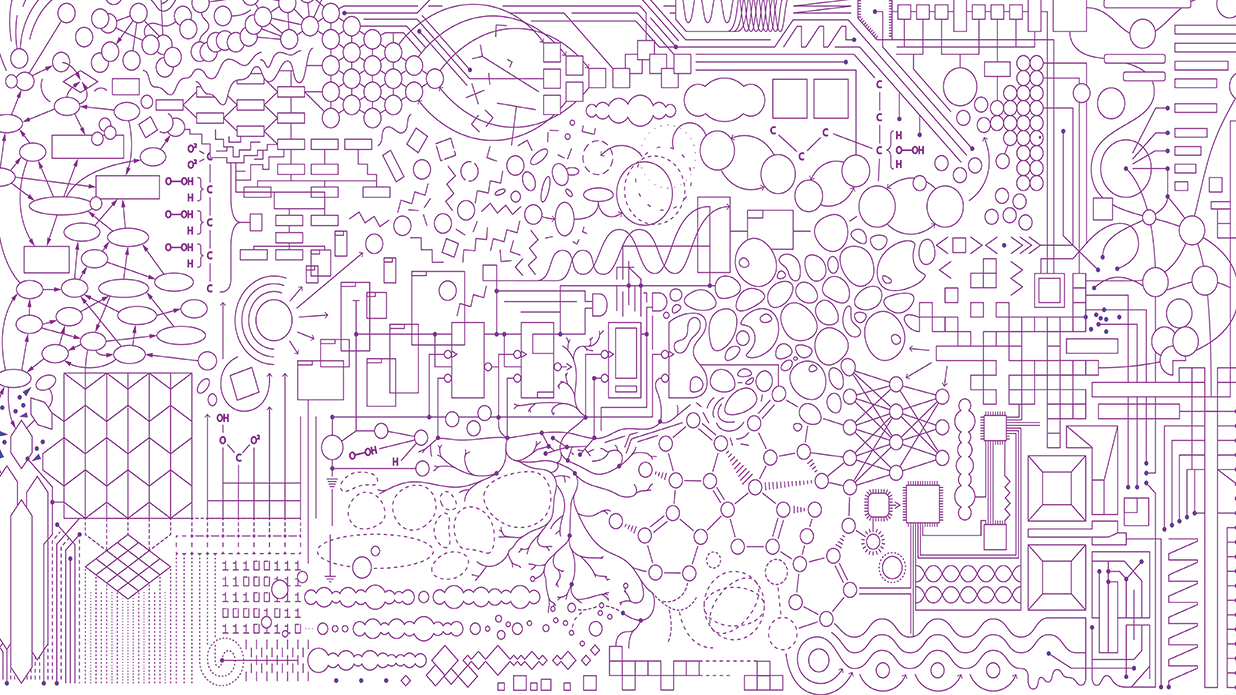
RUTH LORAND

Aryeh Ludwig Strauss (1892–1953) was a German-Hebrew Poet, literary critic and researcher. He was born in Aachen, fought in WWI, worked as a dramaturg in Düsseldorf, studied in Johann Wolfgang Goethe Universität, Frankfurt am Main, and habilitated in Aachen with a study of Hölderlin’s Hyperion (1929). He taught in Aachen as Privatdozent. In April 1933 the ministry of science, art and education in Berlin ordered the rector of the University of Aachen, to dismiss all Jewish professors including Dr. Strauss.
The Strauss family, Ludwig, his wife Eva (Martin Buber’s daughter), and their boys, Immanuel and Michael, lived in Weberstr. 31, Aachen, until Ludwig’s position was terminated. The family left Germany (1935) and immigrated to Palestine, which later became the state of Israel (1948). Ludwig joined Kibbutz Hazorea in which he worked in the fields and made his first steps as a Hebrew poet.

Ruth Lorand
Ruth Lorand is professor emeritus of philosophy and aesthetics at the Department of Philosophy at the University of Haifa. She is an expert in the philosophy of concept forming. Her magnus opus Aesthetic Order. A Philosophy of Order, Beauty and Art was published in 2000 at Routledge after a decade of thorough writing and rewriting. In the preface to this monograph she confessed that Prof. Michael Strauss had inspired her to focus on aesthetic order, “an unpredictable, lawless order”, she said. In other words, a difficult subject worth a decade of exploration to turn into a comprehensive theory.
Prof. Ruth Lorand visited the Käte Hamburger Kolleg “Cultures of Research” in March and April 2023 together with her husband Prof. Giora Hon, professor emeritus of philosophy of science and epistemology at the Department of Philosophy at the University of Haifa. We are very grateful for her visit, her contributions and her blog article about Aryeh Ludwig Strauss, and we hope she will return to Aachen next year for a workshop on concept formation.
Find more information at Ruth Lorand’s academic website.
Later, the family moved to the youth village Ben Shemen where Ludwig taught literature for two years. Jerusalem became afterwards their permanent home and there, at the Hebrew University, A. L. Strauss was among the founders of the Comparative Literary Department. He served as a chair until he got ill; he was replaced by another celebrated Hebrew poet, Leah Goldberg.
My first encounter with the literary work of A. L. Strauss was about 17 years after his passing at the age of 60. In my first year as a student of Hebrew Literature at the University of Haifa I found his name in the required reading list: Studies in Literature by A. L. Straus. It was a most inspiring collection of essays in which I read for the first time a literary analysis of some chapters in Psalm, side by side with an analysis of Goethe’s Faust and Racine’s Phèdre. The introduction to these essays revealed the sad fact, that it was edited and published after the death of the author. The editor was his close friend and a Hebrew poet of German origin as well, Tuvia Rübner, who also edited (together with Hans Otto Horch) Strauss’ Gesammelte Werke (four volumes) and translated to Hebrew some of his poems. Although this was a required reading, it was gratifying due to its clarity and the enlightening observations it offered. In many ways it was an eye opener. From there I went on to reading his Hebrew poems which were not close in content to my world as a young Israeli, but their melody and rhythm reminded me of some Psalm chapters I knew by heart.

It was in my second year at the university, when I took Philosophy as a second subject, that I found another connection to A. L. Strauss. My most beloved and influential philosophy teacher was, as I found out later, the son of the author of my first year compulsory reading. Michael Strauss, whom everybody called Micha, was born in Aachen (1931) and immigrated to Israel with his parents and older brother, Immanuel. Micha was admired by the students who packed his classes on “Modern Philosophy: from Descartes to Kant” and his seminars, “Spinoza’s Ethics”, “Theories of Values”, and a few more. When I began my academic career as a Teaching Assistant in the same Philosophy Department, Micha became my friend and colleague, although it took me a while to address him as Micha and not as Dr. Strauss. We had long and inspiring conversations on literature and philosophy. He hardly mentioned that his father was a known poet and scholar in Germany nor did he ever refer to the fact that the family had been forced to leave Aachen. That Micha was the grandson of the renowned scholar, Martin Buber, was not an issue to be discussed, as the grandson’s philosophical interest was much different from that of his grandfather. However, Micha’s interest in poetry and literary prose was clearly inspired by his father; celebrated poets and philosophers of that time in Israel, were friends of Micha’s family.
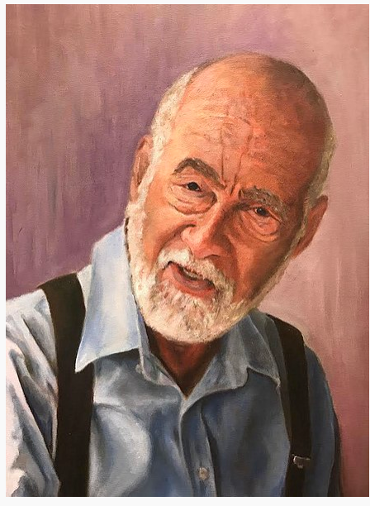
Micha was 22 when he lost his father, and it was quite clear that his soul longed for him and that the connection between them was more than a father-son relation. Micha admired poets and his father among them, but never attempted to write poetry himself. He was a philosopher of the old school, much influenced by the German tradition, who did not publish enough by academic standard, but was endlessly occupied with philosophical issues. His study’s walls were covered with notes written on small pieces of paper. Did he follow his father with this mode of reflection? I don’t know. In the introduction to A. L. Strauss’ collection of papers the editor, Rivner, wrote that the author left mostly scattered drafts, notes, and only a few completed papers. For both, father and son, so it seems, the very act of thinking, reflecting and forming ideas was more important than having them in print. Both father and son were praised as unique and inspiring teachers. I have no first-hand experience with the father’s teaching, but I know that the son, Micha, was my best philosophy teacher and is still today a source of inspiration. By now, both are gone.
In my recent sojourn in Aachen, the birth place of Strauss the poet and Strauss the philosopher, I was curious about their lives in the early 1930s. With the kind and efficient help of the RWTH Archive’s team I found documents related to A. L. Strauss. I was particularly amazed to read a detailed exchange between the ministry of science, art and education in Berlin and the Rector of the Technische Hochschule in Aachen concerning the immediate dismissal of all listed Jewish teachers. A letter sent by the student organization (ASTA) to Berlin declared that German Literature should not be trusted in the hands of teachers who are not of a genuine German origin. Such teachers, so the letter goes, may implant in the students a non-German spirit.
Walking the streets of Aachen in the vicinity of Weberstr. 31, I wondered about the flimsy turns of history. I was thinking about what good literature and philosophy do; how my own life was so deeply influenced by these two Strauss from Aachen.
References
Strauß, Ludwig. 2002. Gesammelte Werke. In 4 Volumes. Eds. Tuvia Rübner and Hans Otto Horch. Göttingen: Wallstein. (Veröffentlichungen der Deutschen Akademie für Sprache und Dichtung Darmstadt. 73) ISBN 3-89244-198-7
Nowhere (to) land? Conference @ RRC
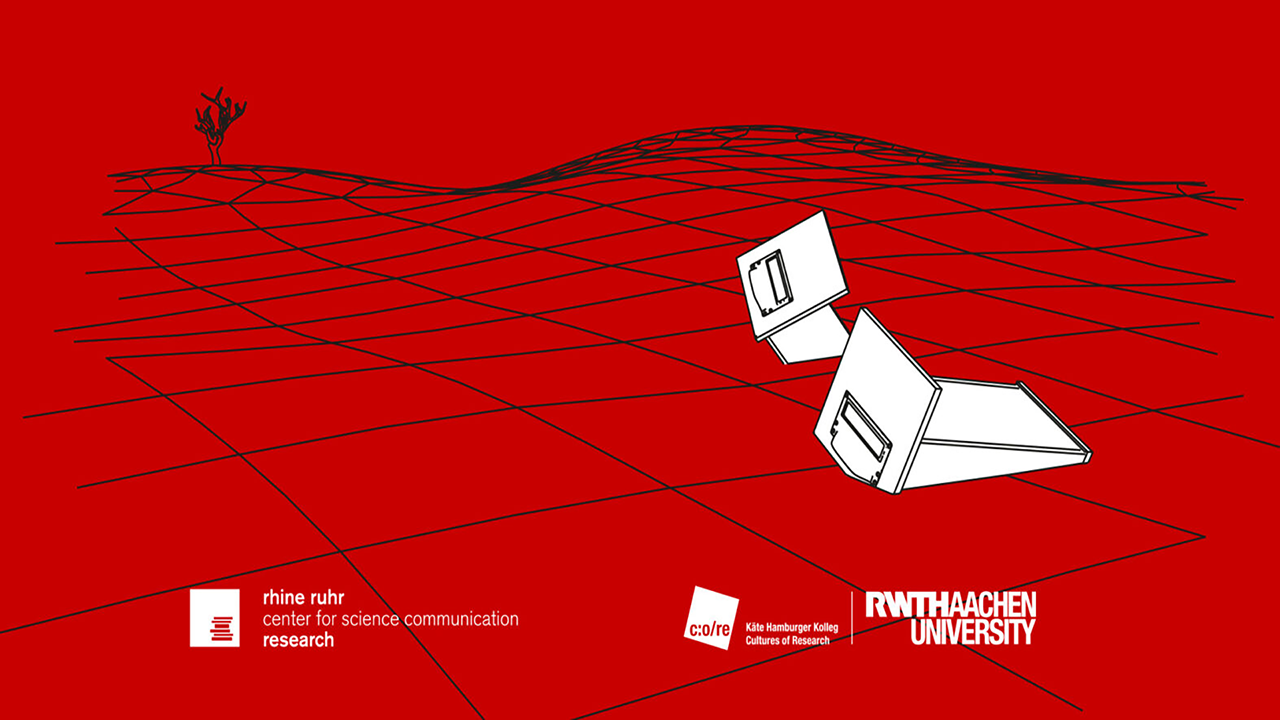
The programme of the conference Nowhere(to) to land?, organized by the rhine ruhr center for science communication is now available at this research centre’s website. c:o/re directors Gabriele Gramelsberger and Stefan Böschen will be present at this event, chairing keynotes and workshops.
You can also read more about the mission of the rhine ruhr center for science communication on the c:o/re blog, in Phillip H. Roth’s post.
“The computer is not in itself rigorous” – Professor Øyvind Eide on digital humanities modelling: between the sciences and the history of the humanities
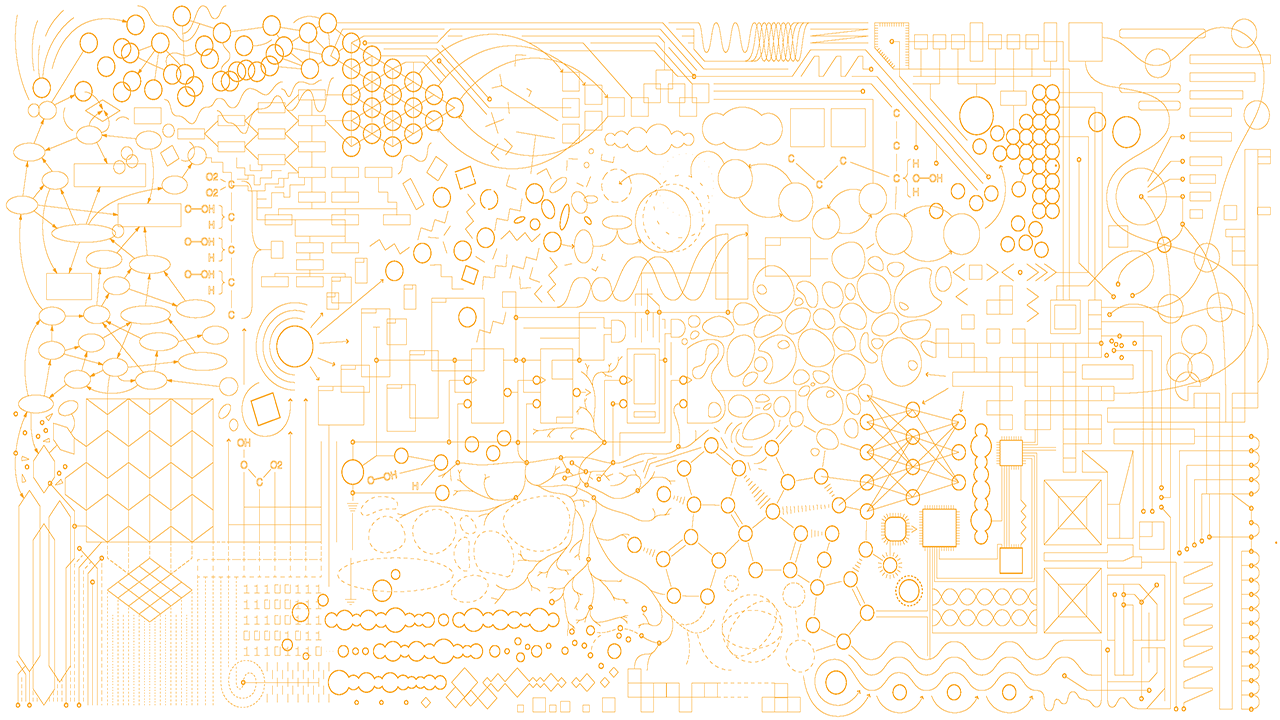
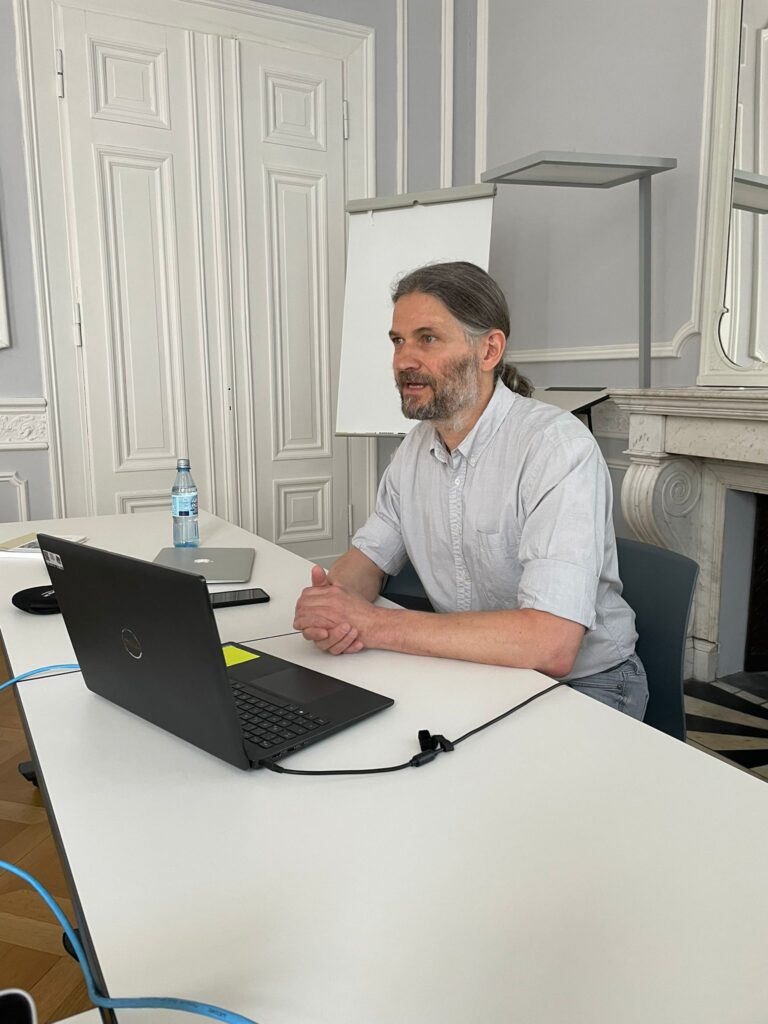
On May 24th, Professor Øyvind Eide delivered a talk at c:o/re on Modelling in digital humanities: between the sciences and the history of the humanities. Øyvind Eide is head of the Institute for Digital Humanities (IDH) at the University to Cologne. The insightful discussion on modelling that he opened revealed not only many common interests between c:o/re and IDH but also how, from the vantage point of digitalization, modelling appears as a key interest in Science and Technology Studies broadly.
Eide’s starting point is that it is misleading to claim a definition of model because anything can be a model of anything else. Efforts to pin it down can only be reductivist to how models are used or irrelevant. Rather, it is insightful to define modelling, as an activity driven by intention. Modelling has a target, namely what is being modelled. This semiotic relation, Eide explains, has to be understood as dynamic. This perspective avoids claims of epistemological objectivity, where represented is deemed unaffected by representation. Eide defines modelling as creative processes of thinking/reasoning that result in meaning, and the negotiation thereof, through the creation and manipulation of external representations. Further, while it escapes definition, a model must always be understood as a media product. Simply, models are mediated.
From this theoretical standpoint, Eide explained the importance and intricacy of numerical mathematics for the digital humanities. This involved a history of the humanities, in reference to notions and means of modelling, that encompassed a broad and illuminating taxonomy. To draw on the role of numerical mathematics in the development of digital humanities modelling, Eide presented the obstacles to be bridged between the scholarly tradition of the humanities and the epistemologies of digital technologies. In brief, the latter are characterised as analogous, continuous, nuanced and hermeneutical, while the latter are formal, rule-based, structured and discrete. This said, Eide further explained that “the computer is not in itself rigorous”.
Any effort to digitalise humanities research, which is a modelling effort, implies a process of intermedial translation. Examples are translating from a paper text page or a paper map page to a scanned text or map page, as a formal model, so to say, in the computer. Of course, from the perspective of the interpreting researcher, the text page is more similar to the scanned text page than to the paper map page. As such, reflection on how models operate at various levels is an analysis of media modalities. Addressing the reduction of complex mathematical models into numerical models, that are computable, then, supposes an intermedial theory of meaning.
These considerations reveal several regards in which a media and semiotic theory of modelling is relevant for contemporary science and technology studies, particularly but not only as an epistemological interest. Having started this dialogue, c:o/re and IDH will now be pursuing ways of collaborating in these directions. We are grateful to Professor Øyvind Eide for this insightful talk.
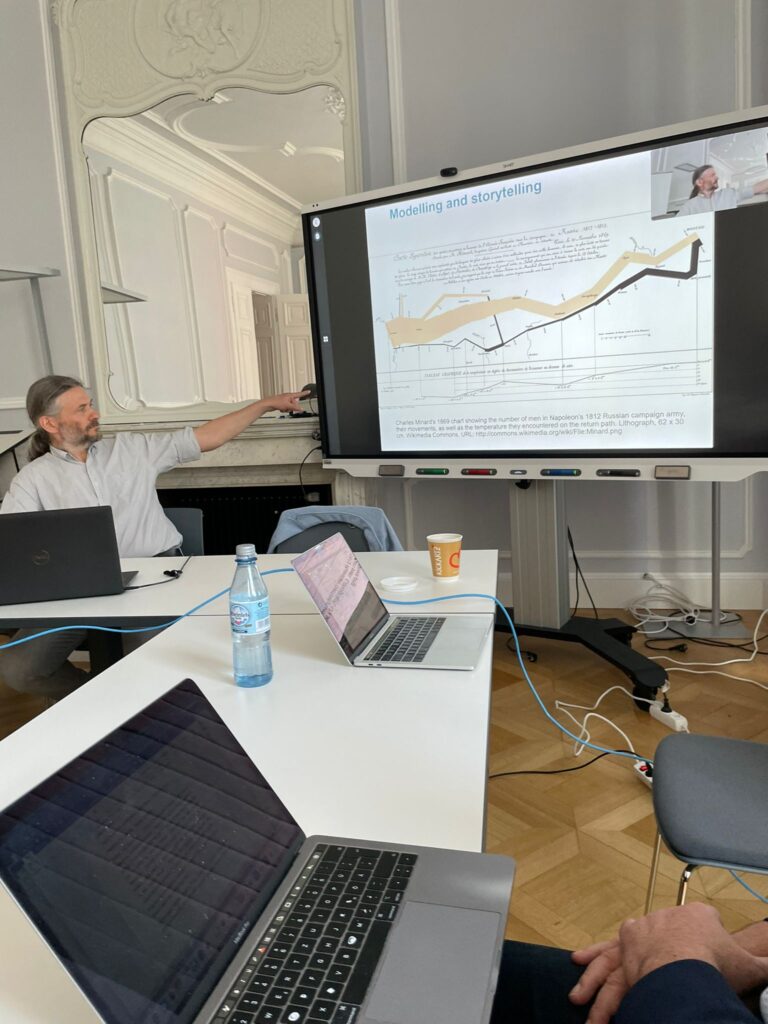
Professor Klaus Mainzer on Complexity: From Natural and Social Sciences to Artificial Intelligence
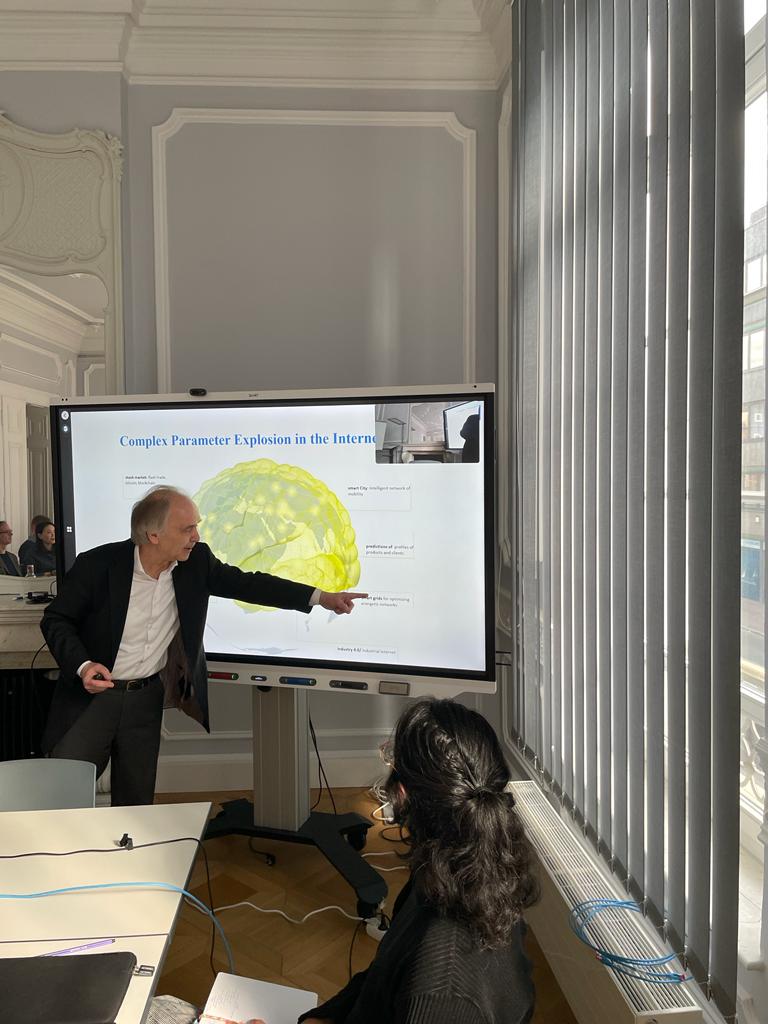
On May 17th, we were delighted to host Professor Klaus Mainzer, who delivered a talk on “Complexity From Natural and Social Sciences to Artificial Intelligence”, as part of the the c:o/re Complexity lecture series. Klaus Mainzer is Professor Emeritus of Philosophy and Philosophy of Science at the Technical University of Munich.
In this talk, he laid a roadmap towards achieving sustainability by starting from theoretical considerations on pattern formation in complex natural systems and moving on to consequences for pattern recognition in complex artificial systems and, then, to discussing complexity in sociotechnical ecosystems.
Recently, results of complexity research have gained salience in machine learning (artificial intelligence) systems (e.g., neural networks, cognitive AI-systems, robots). While complex pattern recognition of AI-systems can and is modelled through statistical learning theory, statistical correlations of data cannot replace causal explanations of events. Mainzer holds that algorithms of causal learning are necessary for the detection of causal models behind the statistical distributions of data. Causal learning, then, would be a first step from weak AI with probabilistic learning to strong AI.
Professor Mainzer explained that the evolution of complex systems demonstrates the critical importance of pattern recognition for learning in general. This is confirmed, as an important example, by results in machine learning, which relies on pattern recognition, as enabled by the mathematical modelling of pattern formation. Shedding light on the importance of human creativity for innovating sustainable development, Mainzer argued that instability and non-linearity are not sufficient for pattern formation. Instead, he pointed to the crucial role of local activity.
In this view, sustainability on a global scale relies on both enhancing machine-to-machine communication, as incarnate in the Internet of Things and progress in the cultural studies, namely the stimulation of human creativity and plurality. Herein it occurs that what may be overlooked as merely theoretical consideration on the mathematics of complexity, actually, has profound implications for human societies, culture, cognition and beyond. The expansion of human societies onto the virtual spaces of the Internet, crossing formerly perceived boundaries and limitations, illustrates the importance of the notion of complexity for understanding contemporary technological, media and cultural processes. As Professor Klaus Mainzer stated, “we cannot programme innovation but we can incentivise it”.
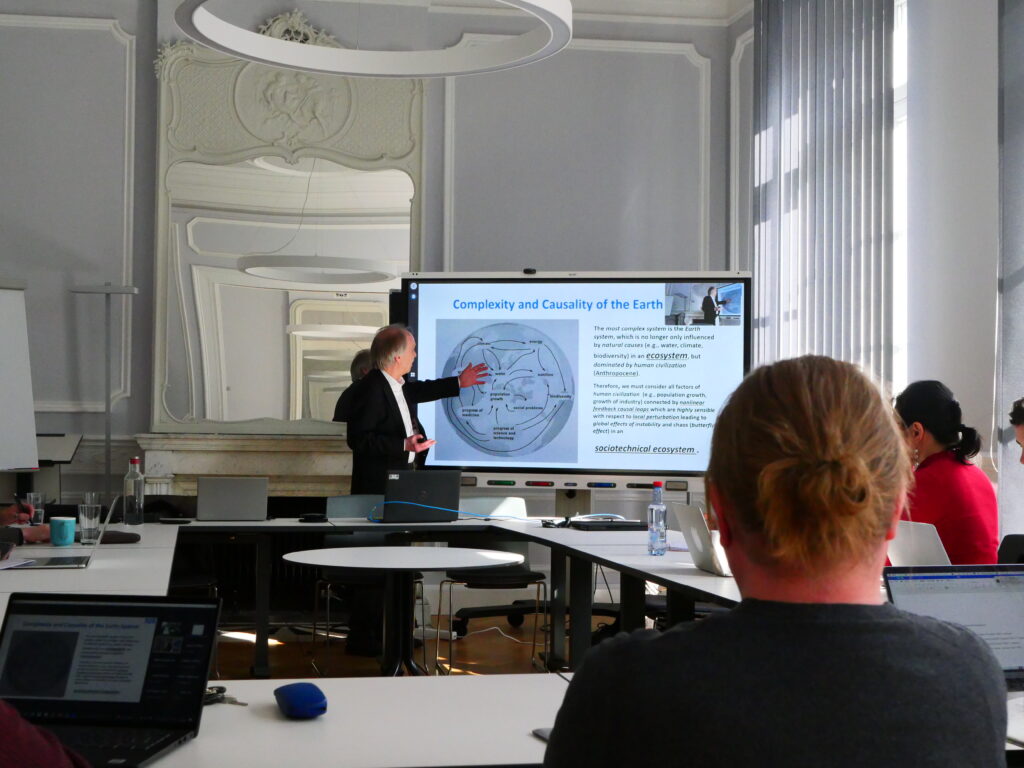
Circulating the STS Hub 2023

STEFAN JOHN
How is STS, as a scholarly discipline, practised in Germany? Which are the approaches to STS here? How do these relate to each other and which topics stimulate joint interdisciplinary and integrated STS research? Which institutions and actors participate in German STS research communities? The new STS-Hub conference series, hosted for the first time by RWTH Aachen University on March 15th-17th 2023 tackled these questions. This event is the result of several years of talks, organization and planning led by, amon others, c:o/re director Stefan Böschen and Ingmar Lippert, whom we cordially welcomed as a short-term c:o/re fellow. The STS Hub is envisioned to move between established and emerging places for STS in Germany and to have a bi-yearly rhythm in-between the EASST Conferences. Financially, the event was institutionally assisted and sponsored by the BMBF, HumTec, c:o/re and several STS networks and clubs such as stsing, INSIST, the science and technology research section at the DGS and the politics, science and technology working group at DVPW.
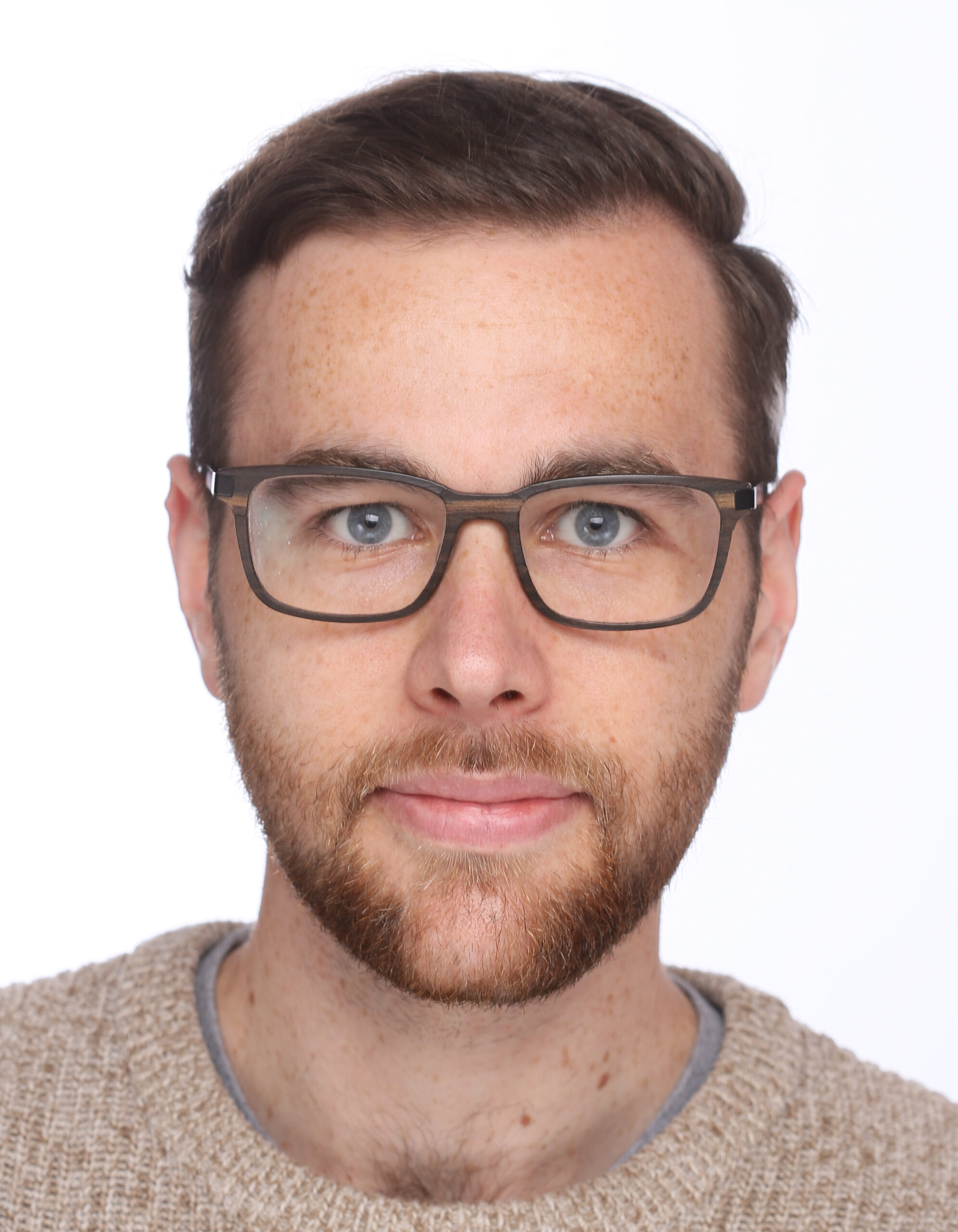
Stefan John
Stefan John is a PhD researcher with the Living Labs Incubator (LLI) located at the Human Technology Center within RWTH Aachen University. His academic work focuses on (power) structures in Living Labs and the modes and understanding of experimentation of (knowledge) infrastructures in contemporary knowledge societies. He is also responsible with supporting the networking and research of LLI. Also, he is currently supporting the c:o/re events team.
Taking all possible roles as part of the local organizing team, panel organizer and panelist, I take the pleasure to briefly convey my experience of the conference and its theme, with a focus on the very insightful keynotes by Ulrike Felt and Susann Wagenknecht.
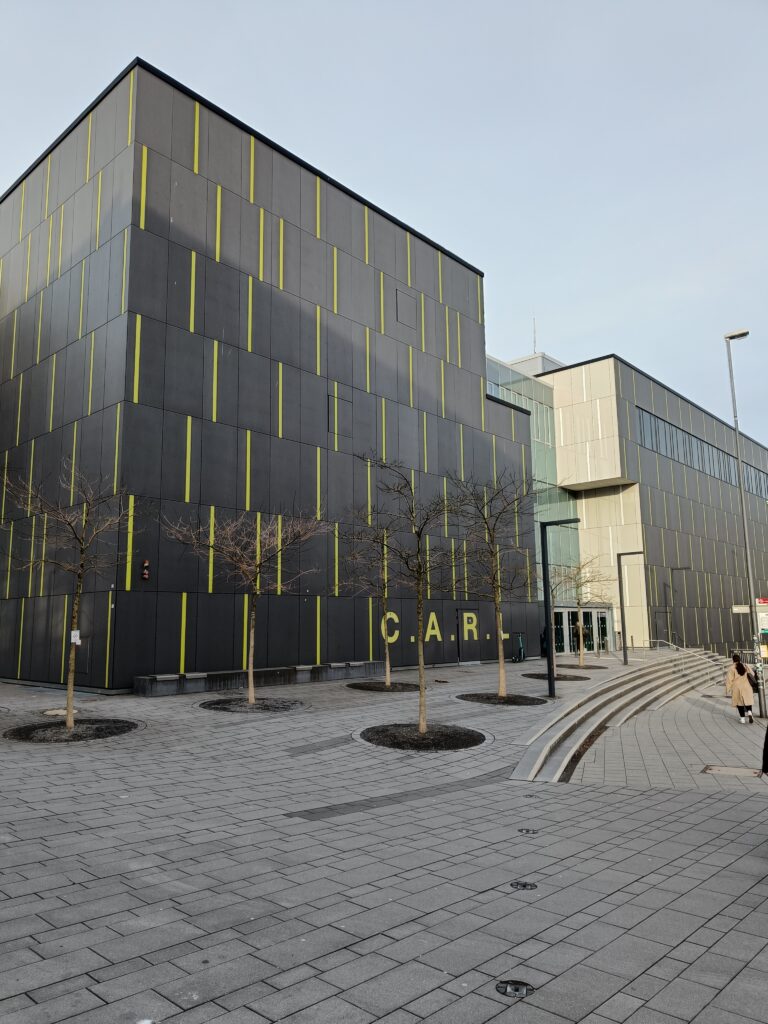
RWTH Aachen offered the Central Auditorium for Research and Learning (C.A.R.L.) as the main venue for the STS Hub.
Before starting the conference and welcoming all guests, INSIST took the chance to make an early career researcher barcamp, discussing the specific needs and problems of this status group and bringing them together. The barcamp format enabled the organisers to allow topics to emerge from direct inputs. To set off, Stefan Böschen and Torsten Voigt, the Dean of the Faculty of Philosophy, took the stage and warmly welcomed the over-300 participants. Following Ingmar Lippert’s short overview of the idea of the STS Hub and its history, STS activities being undertaken at RWTH Aachen were presented in all their varied nuances. Different institutes, chairs and projects, such as the chair of Sociology of Technology and Organization (STO), the chair for Personnel and Organizational Psychology, the Computational Science Studies Lab (CSS), led by Gabriele Gramelsberger, the Human Technology Center, the embedded STS work at the WIRKsam project led by Andrea Altepost and, last but not least, the Faculty of Arts and Humanities, as a whole.

After a short break the first of six session blocks started, each lasting for two hours. A broad variety of topics were discussed in over 65 panels. These stretched from experimental democracy and political views to science and technology, to topic driven panels, e.g. on waste and software studies. The event also comprised experimental formats, such as fishbowl discussions and walkshops, and interdisciplinary topics to foster the circulation of STS ideas with other fields like art and educational studies. Discussions tended to relate, to various degrees, to an interest on the circulation of either knowledge, methods or topics. The theme of circulation is at the very heart of STS research, as particularly evidenced by topics such as the production and utilization of knowledge and expertise, import and dissemination of new technologies and innovation models, e.g. the Zimbabwe Bush Pump or the MIT model of innovation. Circulation stands in proximity to other familiar STS concepts such as infrastructure, translation and power. The Covid-19 pandemic gave prime examples of the circulation of a virus, (un)scientific knowledge, policies and infrastructures in all their contingencies. This virality is entangled with a set of political and normative groundworks, conference program explains that “circulations are never innocent – they can come at high costs for some while benefitting others. Costs and profits often emerge from the intertwinement of different systems of circulation. The circulation of socioeconomic value is contingent on the material circulation of waste in oceans as well as knowledge about their contamination. To circulate or not to circulate evokes questions of solidarity and of violence. Is there a responsibility of STS to resist, disrupt, or prevent some forms of circulation? Which circulations do we care for maintaining?” Another salient theme that emerged from the several panels is that of testing, which involves considerations on experimenting and infrastructures. The keynotes also pondered on this matter.
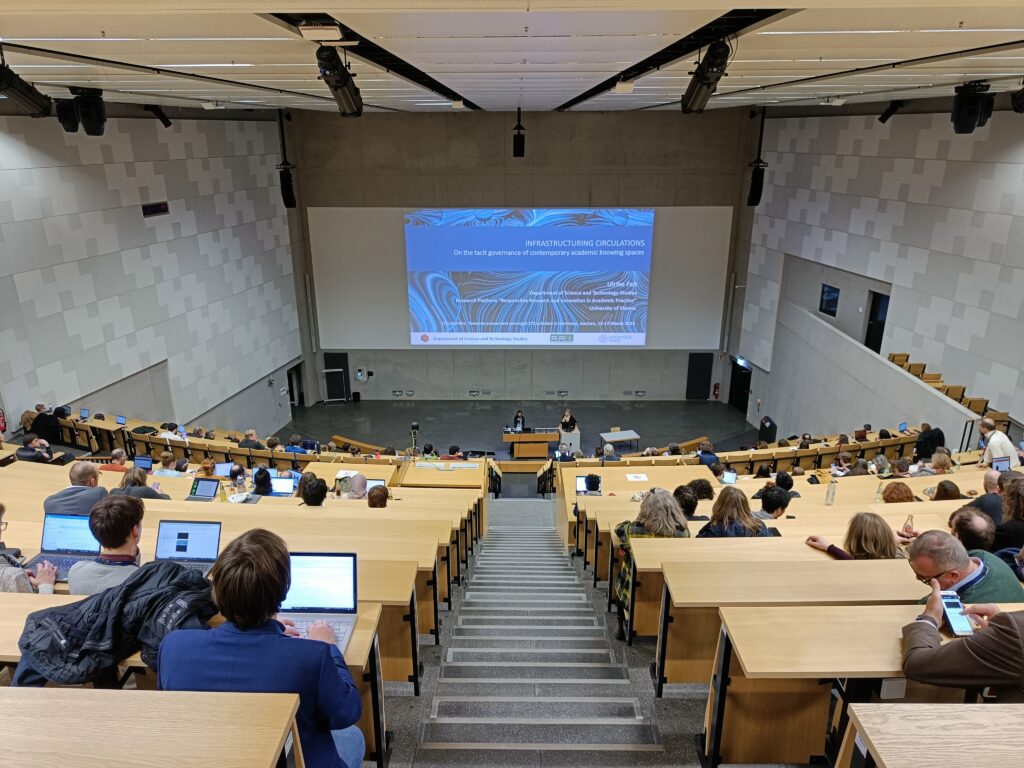
The first keynote, by Ulrike Felt, took a reflexive stance towards the tacit governance of contemporary academic knowing spaces. In her talk, “Infrastructuring Circulations”, she noted two coexisting logics at work in academic environments, namely “a deeply rooted logic of circulation” that encounters an increasing presence of a “logic of infrastructuring”. Reinforcing each other and creating friction (Tsing 2005), they create unique and specific arrangements of research cultures and power. The first conference day ended with a reception for more informal circulations.
Another, this time Latourian, take on circulation was presented by Susann Wagenknecht. Closely dissecting leakages in circulation allows for analysis of the transformation, materiality and morality of circulation. Wagenknecht illustrated this through examples of circular economies and handling of leaks.
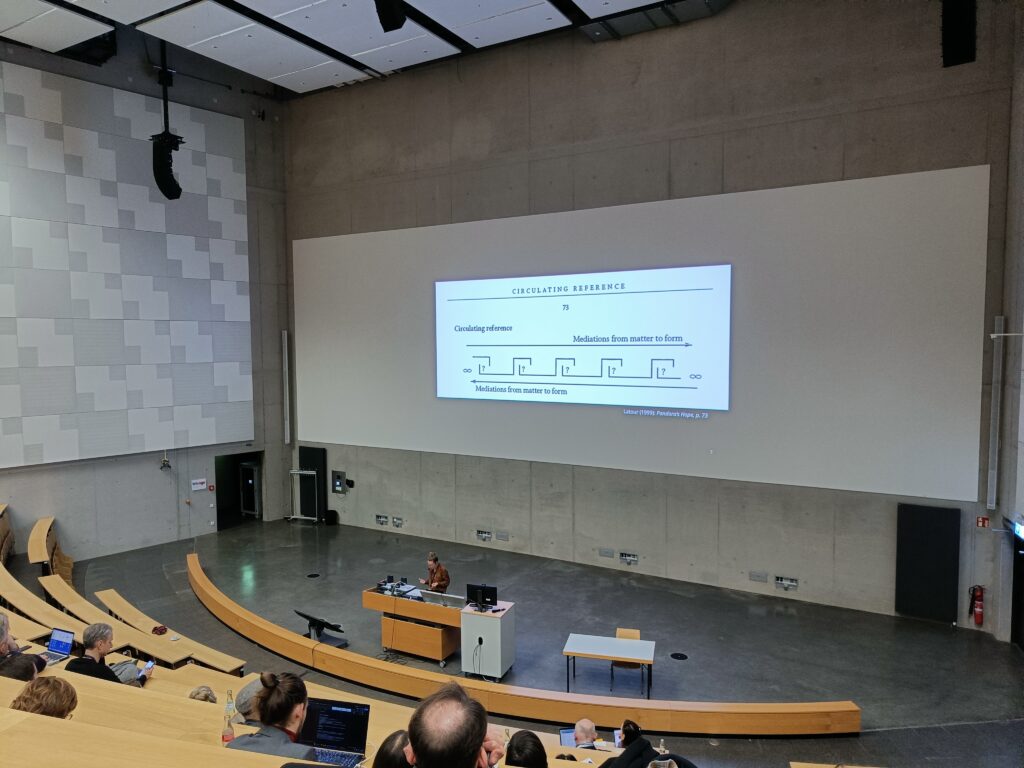
Additionally to discussions on content, the STS Hub also served as a platform to talk about the current state of academia. In the Open Forum #WeDoSTS, Fanny Oehme as Ombudsman, Dr. Claudia Gertraud Schwarz-Plaschg and Dr. Daniel Müller were invited to give accounts on power within STS and the academic system as a whole. As activists against discrimination in general and, more specifically, sexism and abuse of power, they presented the prevalent problems, ways to address them and networks to aid in these situations. After this panel, to open up the debate and offer specific insights, small group discussions were offered by the experts.
The first STS Hub offered an excellent platform for discussion and exchange across hierarchies, new ways of portraying topics in STS through experimental panel formats and an overall welcoming atmosphere for academic collaboration. I would like to wholeheartedly thank Stefan Böschen, Ingmar Lippert and Mareike Smolka for making this Hub possible. We are looking forward to the next one!
For more information and detailed insights on the STS Hub, kindly see the review by Smolka et. al (2023).
Acknowledgements
STS-hub.de 2023 was made possible with the institutional and financial support of Bundesministerium für Bildung und Forschung, stsing – Doing STS in and through Germany, GWTF – Gesellschaft für Wissenschafts- und Technikforschung e.V., INSIST – Interdisciplinary Network for Studies Investigating Science and Technology, Sektion Wissenschafts- und Technikforschung der Deutschen Gesellschaft für Soziologie, Arbeitskreis Politik, Wissenschaft und Technik der Deutschen Vereinigung für Politikwissenschaft, Human Technology Center at RWTH Aachen University, Käte Hamburger Kolleg Aachen Cultures of Research, and RWTH Aachen University. Further support was provided by Kommission Wissenschaftsforschung der Deutschen Gesellschaft für Erziehungswissenschaften, the professorship for Wissenschafts- und Techniksoziologie at TU Dortmund, and the Team Innovativ Beratung UG.
References
Smolka, M., Braun, M., Gruebel, C., Neudert P., Rentrop, C., Wiedemann, L. Being, doing, and using STS in Germany? Reflections on identity questions, normative commitments, and conceptual work after STS-hub.de 2023. EASST Review 42(1).
Tsing, A. L. 2005. Friction: An Ethnography of Global Connection. New Jersey: Princeton University Press.
SFU Workshop on Transdisciplinary Pathways in Educational Research: Learning, ecology, media and beyond
On April 25th c:ore team member Alin Olteanu will be joining Natasa Lackovic (Lancaster University) and Cary Campbell (Simon Fraser University) for an online workshop, organized by the Research Hub @ Faculty of Education of Simon Fraser University, on Transdisciplinary Pathways in Educational Research: Learning, ecology, media and beyond. To attend, please register through the Simon Fraser University website, where you can also find more information. The description of the workshop is also below.
Transdisciplinary Pathways in Educational Research: Learning, ecology, media and beyond
The potential of transdisciplinary research and education has been lauded and discussed for decades. Despite often lofty promises, many have remarked on the lack of meaningful transdisciplinary research and teaching—ironically in universities, where it is most expected. Very little research presents or explores conceptual-philosophical frameworks (or pathways) for how to study and engage in transdisciplinary inquiry and questioning. Our workshop aims to address this theory gap, building from our team’s research expertise in educational semiotics and uniting theoretical perspectives from bio-semiotics, multimodality, and new socio-materiality studies.
Participants and presenters will collaboratively articulate transdisciplinary problems by distinguishing transdisciplinary methodologies and theoretical frameworks from related inter- and cross-disciplinary approaches. We specifically address transdisciplinary challenges associated with climate crisis (the Anthropocene) and the rapid proliferation of digital-media technologies, focusing on the continuity of environmental and embodied learning and digital media-learning.
“The simple is complex”: Professor Giora Hon starts the c:o/re 2023 lecture series on Complexity
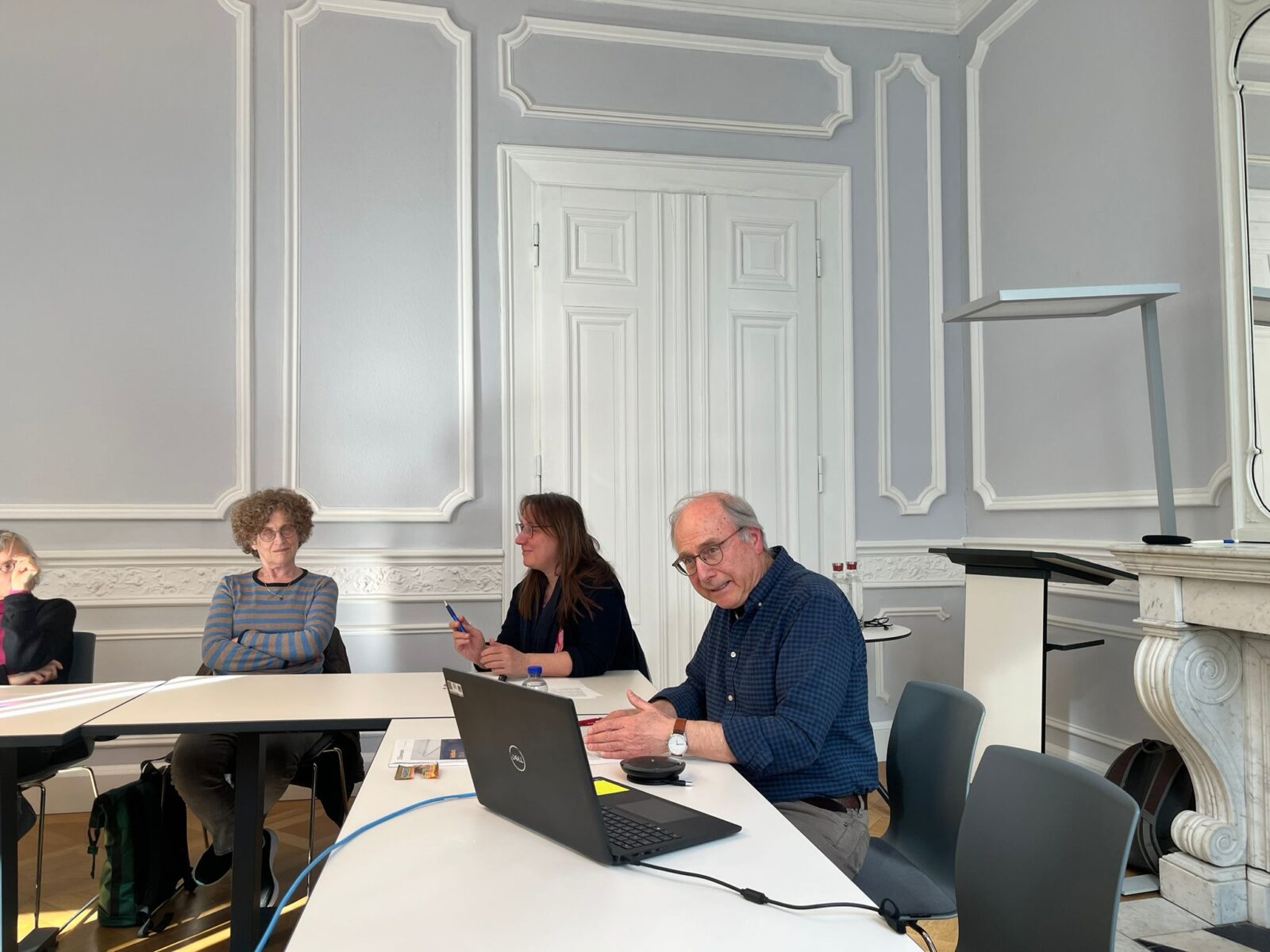

On April 12, 2023, the 5th c:o/re lecture series started off. After c:o/re director Gabriele Gramelsberger welcomed attendees and introduced the speaker, Professor Giora Hon delivered his talk, From Reciprocity of Formulation to Symbolic Language: A Source of Complexity in Scientific Knowledge
Professor Hon introduced his notion of epistemic complexity, which refers to what may be considered simple, rather than complex. The talk was directed at clarifying the oxymoron “the simple is complex”. Professor Hon does so in light of three developments in the history of physics:
- the analogy between heat and electricity, following William Thomson
- the reciprocity of text and symbolic formulation, following James C. Maxwell
- liberating symbolic formulation from theory, following Heinrich Hertz
Professor Hon argued that, following this trajectory of ideas in history of physics, in Hertz the complete separation of formal theory and equations can be observed.
